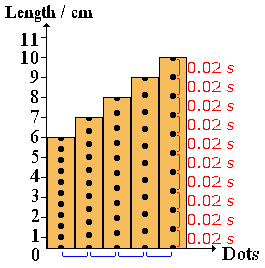Intro
Imagine that a drop of ink falls onto the table every second. The tablecloth is pulled away, but this causes the ink to fall on other spots of the tablecloth as well.
![]()
If the cloth was moved quickly away, the ink blots would be far apart. If the cloth was moved slowly, each ink blot would appear closer to the one before it. By measuring the distances between the dots, it is possible to work out how fast the cloth was moving (like with a pita detik).
Halaju purata
![]()
This is the tape (pita) from the above situation. The distance between the first and last dot is 70 cm, and there are 21 dots in total.
We know that the time between each dot is 1 second. 21 dots means 21 seconds.
Looking back at primary school work: Speed is distance divided by time, so:
| Halaju purata | = 70 ÷ 21 |
| = 3.33 cm s-1 |
Note that 3.33 cm s-1 is the average speed (remember Median, Mean and Mod?) At the beginning, it's much slower than 3.33 cm s-1, and then it accelerates until the middle (where is it faster than 3.33 cm s-1), and then decelerates again.
You would have also gotten about 3.33 cm s-1 for a tape that covers the same distance and has the same number of dots, but has halaju seragam (where the speed is always 3.33 cm s-1):
![]()
Frequency and time between dots
Above, the difference between 2 neighbouring dots is 1 second, so it is easy to count. However, what if there is a higher frequency?
Let's say there are 2 dots every second. That means the difference between 2 dots is 0.5 seconds. If there are 4 dots per second, the difference between 2 dots is 0.25 seconds.
The formula of determining the time between dots is:
| 1 second |
| -------------------- |
| number of dots |
Usually, the jangka masa detik has a frequency of 50 Hz. That means 50 dots need to be squeezed into the time frame of 1 second (or 1 second has to be divided among 50 dots)
| Time between dots | = 1/50 |
| = 0.02 s |
Pecutan
When given a single tape, you can only determine the average speed of the entire movement. However, if you cut it up into different sections, you can find the average speed for each little section. From that, you can work out the acceleration.
 |
Consider this "tape chart": A dot tape made by an
accelerating trolley is cut into 5 segments and placed side by side. The
jangka masa detik used a frequency of 50 Hz to mark the dots.
It can be said that each tape segment has 10 dots, but look closely at the longest tape: There are 9 dots in the middle and 2 half-dots at either end. This makes 10 'spaces' between neighbouring dots/half-dots in each tape. Remember, each space represents 0.02 seconds so each tape segment represents 0.2 seconds. (0.02 X 10) (Note: My main intention of pointing this out is to show you that it is the difference between 2 marks that is significant. However, this detail doesn't become a big issue. If you're told "each section has 10 dots", you can assume that there are 10 spaces) Now, treat each tape segment as a separate individual tape and calculate the speed for each one. |
1st tape 2nd tape 3rd tape
|
4th tape 5th tape * speed = distance ÷ time |
The formula for acceleration is a = (v - u) ÷ t. In other words, acceleration is the difference between two velocities, divided by the time taken.
Usually, when dealing with this type of dot tapes, the last and first tapes are used. (You can also use any two tapes in the middle). Let's work out the acceleration for the tapes in the diagram
| Final velocity, v | = 50 cm s-1 (5th tape) |
| Initial velocity, u | = 30 cm s-1 (1st tape) |
| Total time, t | = 0.2 X 4 = 0.8 s |
| Acceleration, a | = (v - u) ÷ t = (50 - 30) ÷ 0.8 = 25 cm s-2 |
For the total time, you might have been thinking of doing 0.2 X 5 = 1.0 s ...After all, there are 5 tapes! But remember that it's the difference we're looking for. Look at the blue brackets in the diagram: There are 4 'space's between the tapes.